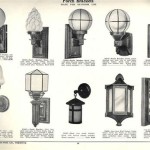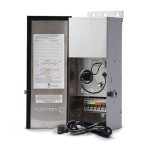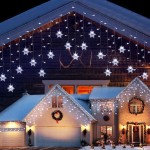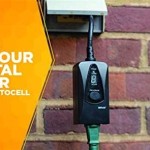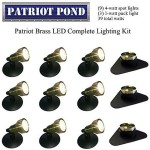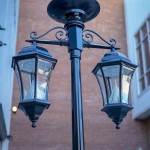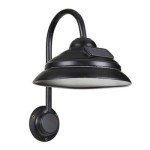```html
Lumens for Outdoor Flood Lights: A Comprehensive Guide
Outdoor flood lights serve various purposes, from enhancing security and safety to accentuating architectural features and illuminating recreational areas. The effectiveness of a flood light hinges heavily on its lumen output, which dictates the brightness and coverage area. Understanding the relationship between lumens and the intended application is crucial for selecting the appropriate flood light.
Lumens are a measure of the total amount of visible light emitted by a light source. Unlike watts, which measure energy consumption, lumens directly indicate the brightness of a light. A higher lumen value signifies a brighter light. However, simply opting for the highest lumen count available is not always the best strategy. The optimal lumen output depends on several factors, including the size of the area to be illuminated, the desired level of brightness, and the presence of ambient light sources.
Different applications require different lumen levels. A small pathway light might only need a few hundred lumens, while a large parking lot will demand thousands. Over-illumination can be just as detrimental as under-illumination, contributing to light pollution and potentially causing discomfort or visual glare. Therefore, a careful assessment of specific needs and environmental factors is essential.
The shift towards LED technology has significantly impacted the landscape of outdoor flood lighting. LEDs offer greater energy efficiency, longer lifespan, and comparable or superior lumen output compared to traditional incandescent or halogen bulbs. This allows for brighter illumination with lower energy consumption, translating to cost savings and reduced environmental impact.
Understanding Lumen Requirements for Different Outdoor Applications
The first step in selecting a flood light is to define the specific purpose it will serve. Illuminating a driveway requires a different approach than lighting a backyard patio or a commercial loading dock. Each application demands a unique balance of brightness, coverage area, and beam angle.
Driveway Lighting: For residential driveways, a flood light with 700 to 1300 lumens is generally sufficient. This range provides adequate illumination for safely navigating the driveway at night, while also deterring potential intruders. Placement is crucial; mounting the light above the garage door or on the side of the house, angled downwards, can effectively illuminate the driveway without causing excessive glare. Consider motion-activated lights for added security and energy savings.
Pathway Lighting: Pathways require a gentler illumination than driveways. Flood lights in the 200 to 800 lumen range are typically adequate for providing safe and comfortable passage. These lights should be positioned to cast a soft glow along the pathway, highlighting the edges and preventing tripping hazards. Solar-powered path lights are a popular and energy-efficient option for these applications.
Backyard Lighting: The lumen requirements for backyard lighting vary depending on the size and purpose of the space. A small patio or deck may only need 400 to 1000 lumens to create a warm and inviting atmosphere. Larger backyards used for recreation or entertaining may require 1500 to 3000 lumens or more. Consider using multiple flood lights strategically positioned to provide even illumination and highlight specific features, such as landscaping or outdoor furniture.
Security Lighting: Security lighting prioritizes brightness and coverage to deter criminal activity. Flood lights with a lumen output of 2000 to 4000 lumens are commonly used for security purposes. These lights should be positioned to illuminate vulnerable areas, such as entrances, windows, and dark corners. Motion-activated lights are highly recommended, as they provide an instant burst of light when triggered, alerting residents to potential threats and deterring intruders.
Commercial Applications: Commercial properties often require significantly higher lumen outputs than residential properties. Parking lots, loading docks, and building exteriors may require flood lights with lumen outputs ranging from 4000 to 10,000 lumens or more. These lights should be strategically positioned to provide comprehensive coverage and ensure the safety and security of employees, customers, and visitors. Compliance with local lighting ordinances and regulations is also essential in commercial settings.
Factors Influencing Lumen Selection
Beyond the specific application, several other factors influence the optimal lumen output for outdoor flood lights. These factors include the color temperature of the light, the beam angle, the mounting height, and the presence of ambient light.
Color Temperature: Color temperature, measured in Kelvin (K), describes the warmth or coolness of the light emitted. Lower color temperatures (2700K-3000K) produce a warm, yellowish light that is often preferred for residential applications, creating a cozy and inviting atmosphere. Higher color temperatures (4000K-5000K) produce a cool, white light that is better suited for security and task lighting, providing greater visibility and clarity. The choice of color temperature can influence perceived brightness; a cooler light might appear brighter than a warmer light with the same lumen output.
Beam Angle: The beam angle refers to the spread of light emitted by the flood light. A narrow beam angle focuses the light on a smaller area, providing concentrated illumination. This is useful for highlighting specific features or objects. A wide beam angle disperses the light over a larger area, providing broader coverage. The choice of beam angle depends on the desired effect and the size of the area to be illuminated. For example, a narrow beam angle might be used to highlight a statue, while a wide beam angle would be more suitable for lighting a parking lot.
Mounting Height: The mounting height of the flood light also affects its effectiveness. Higher mounting heights generally require higher lumen outputs to compensate for the increased distance. Additionally, the angle at which the light is mounted can influence the coverage area and the potential for glare. Experimentation with different mounting heights and angles may be necessary to achieve the desired illumination.
Ambient Light: The presence of ambient light from streetlights, neighboring properties, or the moon can significantly affect the perceived brightness of the flood light. In areas with high levels of ambient light, a lower lumen output may be sufficient. Conversely, in dark areas with minimal ambient light, a higher lumen output may be necessary to achieve adequate illumination. Consider the surrounding environment when selecting the appropriate lumen output.
Choosing the Right Flood Light Technology and Features
While lumens are a crucial factor, the type of flood light technology and its features also play a significant role in overall performance and suitability. LED flood lights have become the dominant choice due to their energy efficiency, long lifespan, and versatility. However, understanding the differences between various LED models and features is essential for making an informed decision.
LED Flood Lights: LED flood lights consume significantly less energy than traditional halogen or incandescent flood lights, resulting in substantial cost savings over time. They also have a much longer lifespan, reducing the need for frequent replacements. LED flood lights are available in a wide range of lumen outputs, color temperatures, and beam angles, making them suitable for various applications. Look for LED flood lights with a high Color Rendering Index (CRI) for accurate color representation.
Motion Sensors: Motion-activated flood lights are a valuable addition for security purposes. They automatically turn on when motion is detected, providing an instant burst of light that can deter intruders and alert residents to potential threats. Motion sensors can also be adjusted for sensitivity and duration, allowing for customization based on specific needs and environmental factors. Some motion sensors also feature a dusk-to-dawn mode, automatically activating the light at dusk and deactivating it at dawn.
Dusk-to-Dawn Sensors: Dusk-to-dawn sensors automatically turn the flood light on at dusk and off at dawn, providing continuous illumination throughout the night. This is particularly useful for security lighting and for illuminating walkways and driveways. Dusk-to-dawn sensors can save energy by ensuring that the light is only on when it is needed.
Smart Flood Lights: Smart flood lights offer advanced features such as remote control, dimming capabilities, and customizable schedules. They can be controlled via a smartphone app or voice assistant, allowing for convenient adjustment of brightness and color temperature. Some smart flood lights also integrate with other smart home devices, enabling coordinated lighting scenarios and enhanced security features.
Durability and Weather Resistance: Outdoor flood lights are exposed to the elements and must be durable enough to withstand harsh weather conditions. Look for flood lights with a high Ingress Protection (IP) rating, which indicates the level of protection against dust and water. An IP65 rating or higher is recommended for outdoor applications. The housing should be constructed from durable materials, such as aluminum or polycarbonate, to resist corrosion and impact damage.
Choosing the right lumens for outdoor flood lights requires careful consideration of the intended application, environmental factors, and desired features. By understanding the relationship between lumens and brightness, and by considering the various factors that influence illumination, individuals can make informed decisions that enhance safety, security, and the overall aesthetic appeal of their outdoor spaces. Properly selected and installed flood lights can provide years of reliable service, contributing to a safer and more enjoyable environment.
```
Led Flood Lights What You Need To Know

How Many Lumens Outdoor Landscape Lights Need To Work Well

Led Flood Lights What You Need To Know

How Many Lumens Do You Need For Outdoor Lighting

How Many Lumens Do You Need For Outdoor Lighting

How Many Lumens Do I Need For Outdoor Flood Light Ledmyplace

Probrite 400w Equivalent Integrated Led Broe Outdoor High Output Flood Light 12 000 Lumens 4000k Dusk To Dawn Pwrfx110 Pc 4k Bz The Home Depot

Sansi 45 Watt 6000 Lumens 5000k White Outdoor Integrated Led Flood Light 01 04 001 024501 The Home Depot

Lampu Sorot Led Rumah Outdoor Flood Light 4500 Lumens 50w Cool White Durasi Hidup 30 000 Hours Temperatur Warna Cold 6000 6500k Hitam 50 Watt Lapangan

Led Flood Light 30w 5000k With Yoke Mount 3999 Lumens Ledradiant
Related Posts
